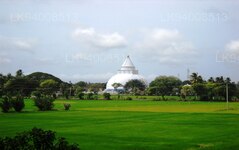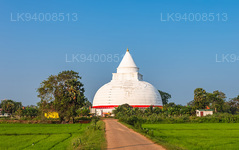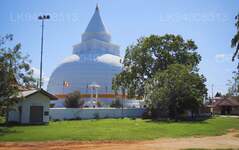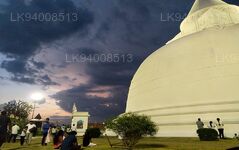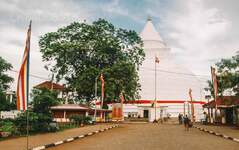
Tissamaharama City
Nestled in the heart of Tissamaharama, our hotel offers a tranquil retreat surrounded by nature. With comfortable accommodations, modern facilities, and a central location, guests can enjoy a peaceful stay. Explore nearby attractions like Yala National Park, historic temples, and scenic lakes, creating lasting memories during your visit.
Tissamaharama Raja Maha Viharaya
Tissamaharama Raja Maha Vihara, üblicherweise „Tempel von Tissa“ genannt, ist eine 55,8 m hohe Dagoba, in der vermutlich eine heilige Zahnreliquie und eine Stirnknochenreliquie aufbewahrt werden. Der angrenzende Wewa (See) soll um 200 v. Chr. von König Kavantissa erbaut worden sein und ähnelt dem in der guten alten Zeit üblichen Konzept von „See und Tempel“. Neben der Dagoba steht eine Statue der heldenhaften Königin Viharamahadevi; Sandagiri Stupa, vermutlich der älteste Stupa im Süden Sri Lankas und im Gebiet des Kriegerclans „Kshatriya“. In der Stupa sind Reliquien aufbewahrt, die Kaiser Asoka als Geschenk erhalten hat. Unter den Ruinen befindet sich ein „Siri Pathul Gal“ (in Felsplatten gemeißelter Fußabdruck Buddhas) aus dem 2. bis 3. Jahrhundert v. Chr.; Kirinda Raja Maha Vihara, etwa 10 km südlich von Tissa, ist der Ort, an dem der Legende nach Prinzessin Viharamahadevi an Land trieb. Sie wurde von ihrem Vater, König Kelanitissa von Kelaniya (in der Nähe von Colombo ), als Buße dem Meer geopfert, nachdem er einen Mönch getötet hatte. Anschließend heiratete sie König Kavantissa, den Herrscher des Ruhunu-Königreichs. Ihre Söhne waren Dutugemunu und Tissa. Ersterer ist der allzeit bewunderte singhalesische König , der Anuradhapura im 2. Jahrhundert v. Chr. von indischen Invasoren, nämlich König Elara, befreite und das Land vereinte.
In der Stadt Tissamamarama liegen vier antike Stupas aus der Anuradhapura-Ära in einer Reihe. Diese sind
- 1. Sandagiri Stupa
- 2. Tissamaharama Stupa
- 3. Yatala Vehera
- 4. Menik Vehera
Von diesen ist die am meisten verehrte und größte die Tissamaharama-Stupa. Alten Chroniken zufolge wurde diese Stupa von König Kavantissa erbaut, der im 1. Jahrhundert v. Chr. über Ruhuna herrschte. Man geht jedoch auch davon aus, dass dieser Stupa ursprünglich im 3. Jahrhundert v. Chr. vom regionalen König Mahanaga erbaut wurde und König Kavantissa den Schrein wahrscheinlich vergrößerte.
Mahanaga ist ein Bruder von König Devanampiyathissa (150–210 v. Chr.). Die Geschichte besagt, dass Mahanaga, als er den Bau des Walas-Reservoirs (වලස් වැව) inspizierte, ihm von der Königin von Devanampiyathissa eine Schüssel Mangos schickte, von denen die oberste vergiftet war. Ihre Absicht war es, Mahanaga zu töten, um ihrem Sohn nach Devanampiyathissa den Thron zu sichern. Zu dieser Zeit war der Sohn bei seinem Onkel am Tank und das Kind aß die vergiftete Mango und starb auf der Stelle. Aus Angst vor Repressalien nahm er seine schwangere Frau und floh nach Ruhuna, wo er rund um die Gegend von Magama sein eigenes regionales Königreich aufbaute.
About Hambantota District
Hambantota is a rural town in southeastern coastal area of Sri Lanka. It is also the capital of the Hambantota District in the Southern Province of Sri Lanka. Approximately 240 kms from Colombo, Hambantota is in the midst of transformation into a strategic port and commercial centre, undergoing extensive infrastructure development. Flanked by sweeping sandy beaches, Hambantota is a convenient location from which to visit nearby sights.
The Bundala National Park lays 20 km east of Hambantota and the Wirawila Sanctuary a little further off. The Ruhuna National Park and the Kataragama Temple are other attractions that can be accessed easily from this city.
About Southern Province
The Southern Province of Sri Lanka is a small geographic area consisting of the districts of Galle, Matara and Hambantota. Subsistence farming and fishing is the main source of income for the vast majority of the people of this region.
Important landmarks of the Southern Province include the wildlife sanctuaries of the Yala and Udawalawe National Parks, the holy city of Kataragama, and the ancient cities of Tissamaharama, Kirinda and Galle. (Although Galle is an ancient city, almost nothing survives from before the Portuguese invasion.) During the Portuguese period there were two famous Sinhalese poets called Andare who was from Dickwella and Gajaman Nona who was from Denipitiya in Matara District, composing poems on common man.

